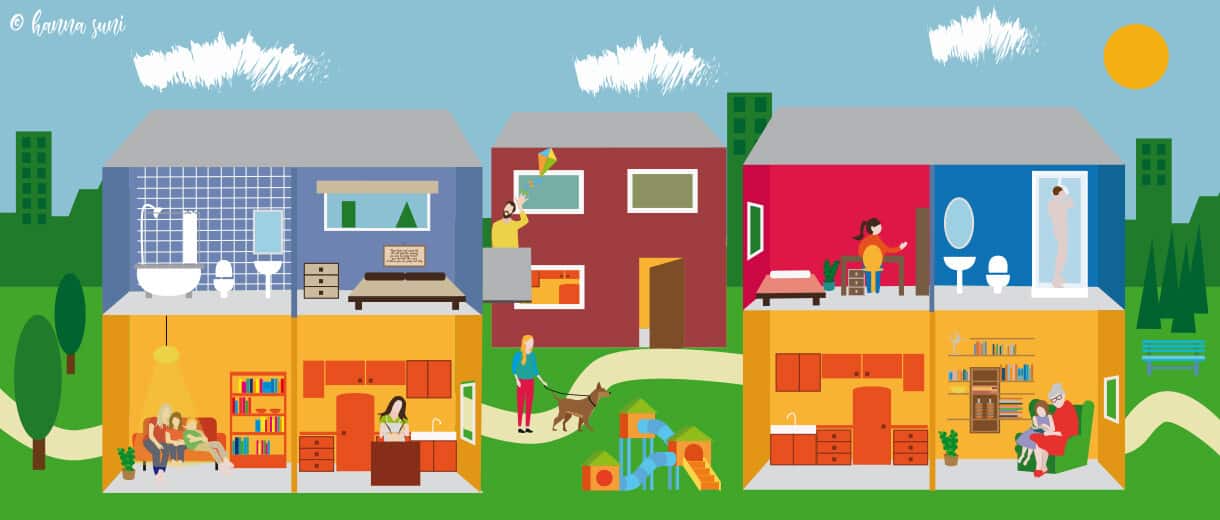Age In Place: The Many Benefits of Co-housing
One of the major questions of growing older is, “where do I want to live as I age?”. Cohousing – living in a community of like-minded people, sharing common spaces, resources and initiatives – can turn out to be the perfect option for many, from single parents to elderly people and families who can benefit from the help and company of neighbours. A valid living option and a compromise between having your own, private space and sharing the joys and struggles of your daily life with a community of like-minded people.
“Co-housing is a community at its best. You have the opportunity to really grow as a human being, learn to get along better with others and to navigate conflict more wisely”, says Dr Erica Elliott who lives at the Commons in Santa Fe, New Mexico. Commons was initiated in 1991 and completed in 1997 as one of America’s first co-housing projects. As a middle-aged single mother, Erica was able to raise her son in a community that feels almost like an enlarged family.
Community at its best
Co-housing is collaborative spaces which typically include a common house with a large kitchen and dining room, laundry, and recreational areas and outdoor walkways, open space, gardens, and parking. Neighbours use these spaces to play together, cook for one another, share tools, and work collaboratively while the common property is managed and maintained by community members, providing even more opportunities for growing relationships.
Initiated in Denmark in the late 1960s when a group of dual-income professional families was searching for better childcare and a way to share evening meal preparation, Co-housing has now been experienced by several groups around the world. Nearly 300 projects have been completed in Denmark since the first community, Settedeammen, was launched. In nearly 50 years of its history, the concept of cohousing has matured, and now embraces an intergenerational mix of family types, which makes it attractive to young families and single parents as well as to retired couples and singles. In North America, more than 65 cohousing communities have been completed, and hundreds of groups are meeting regularly trying to make their projects happen.
Could cohousing be the perfect option for you?
In today’s society, people tend to live by themselves or in small, isolated groups. According to Statista, in 2019 over 60% of the UK households comprised of one or two people, whereas in the US, the average number of people in a household was 2,5. While privacy and independence are highly valued and searched for, we often struggle with the number of daily chores, the number of expenses, as well as with logistics of running our families, houses and lives, especially at midlife.
Many suffer from anxiety and loneliness, as throughout the history of mankind, humans have longed to be part of a community. Whether for safety and security or for the sense of belonging to a group, we need to interact with other people and feel part of a whole.
According to Lisa Berkman, Professor of Public Policy at Harvard University, co-housing harkens back to the kinds of communities that used to naturally dominate our societies. It allows for people to age in their homes even in Western countries where independence is highly valued and elderly people are often placed in retirement homes. Being surrounded only by your peers – other mature people – does not give the same stimulus as living in a heterogeneous group does.
Trish Becker-Hafnor – a strong advocate of cohousing communities – says that valuing relationships and the willingness to share your time, space and values with others is crucial in order to thrive in cohousing. “My favourite thing about cohousing is the sharing of wisdom and support across the generations”, she admits.
The future of sustainable living
Although the first cohousing projects were initiated by rather homogenous groups, anyone can live in such an environment. There are inspiring examples of co-housing for single mothers as well as projects such as OWCH, where over a dozen older women in the UK are living together, taking care of each other and keeping company. The ideal cohousing group consists of a mix of singles, couples, families with children and the elderly. In this way, you get a small balanced mini-society where the combined skills complement each other. Someone who is retired may want to babysit the children in the community, while the younger generation can take care of the heavier jobs.
Benefits of cohousing
The benefits of clustering the private dwellings in a community include environmental protection, energy conservation, reduced infrastructure costs, increased open spaces and the promotion of human interaction. Cohousing groups often design smaller, more efficient private units so that they can accommodate a larger “common house.” Residents choose to include amenities such as a kitchen and dining area, children’s play areas, laundry, a library or lounge, guest rooms and workshop facilities in their common house. Unlike housing built by a developer, a cohousing project will generally include many unit types, ranging from studios to four or five bedrooms. This range of choices better serves the diverse needs and family types of a cohousing community.
Everywhere, people talk about feeling isolated or not feeling safe in their own home – Chris Hanson, author of ‘The Co-Housing Handbook‘, says-. In today’s fast-paced world of competition and lonely individualism, we need a place to belong, a place where we feel safe and supported. And yet, when we need to get away, we need a place to be by ourselves — quiet, separate and secure.
According to him, there are over a dozen benefits of living in a cohousing community:
- A safe and supportive environment where people will look out for each other and strangers are spotted and questioned instantly.
- Opportunities for social interaction without sacrificing privacy.
- Sharing skills and talents with other members of the community such as cooking, making music, fixing things, gardening.
- Access to many more facilities: gardens, play areas, workshops, darkrooms, crafts rooms, lounges and larger kitchens and dining areas are often part of cohousing common facilities.
- Raising children in a community is especially useful for single parents. Children have safe places and appropriate facilities in which to play outside of their homes. Children have playmates within their community. Parents have others to share childminding duties with.
- Sharing resources with others puts less strain on the environment. Working as a group, there are more opportunities to reduce, reuse and recycle and no need for each family to buy utensils.
- By clustering the homes, cohousing communities preserve much of the green space on the site where a traditional neighbourhood would use every last inch for houses, streets and parking.
- Shared meals, bulk buying, sharing of resources such, carpooling, sharing babysitting, trading goods and less travel due to more on-site activities are some examples of how daily living costs can be reduced.
- Cohousers have more free time because of shared meals, shared chores, less travel time due to more on-site activities, and less time minding the kids.
- Consensus decision making empowers all residents. Everyone’s point of view must be shared and considered in planning and managing the community.
- Living with people of all ages provides a diversity of experience for both young and old. Most communities separate ages and family status – cohousing brings them together.
The ideal size of a co-housing community is anywhere from 10 up to 35 or 40 households. If the community is smaller, its smooth operation depends too much on specific individuals; if larger, some of the sense of community becomes lost.
The future way of living
Cohousing projects are getting more popular all over the world. There are initiatives and associations all over the world, in Italy, Britain, Denmark, America and Germany, only to name a few countries.
“Living together is part of the historical culture of sharing that is being rediscovered all over the world by people who activate public spaces, work in shared offices or live in contractual communities”, writes Emanuele Giorgi in his recently released book The Co-Housing Phenomenon: Environmental Alliance in Times of Changes. He presents 50 case studies of contemporary co-housing projects spread all over the world to show how communities of shared living have become a global phenomenon that can serve as a tool to promote social and urban sustainability.
If you are interested in starting a project of your own, check out the guides by cohousing experts Kathryn McCamant and Charles Currett: CoHousing: A Contemporary Approach to Housing Ourselves and Creating Cohousing. They can be helpful in the first steps. “If we want to create more sustainable, affordable and attractive cities, co-housing is the way to go”, states Eef Tanghe in her TEDTalk, promoting the positive aspects of living in a community.





